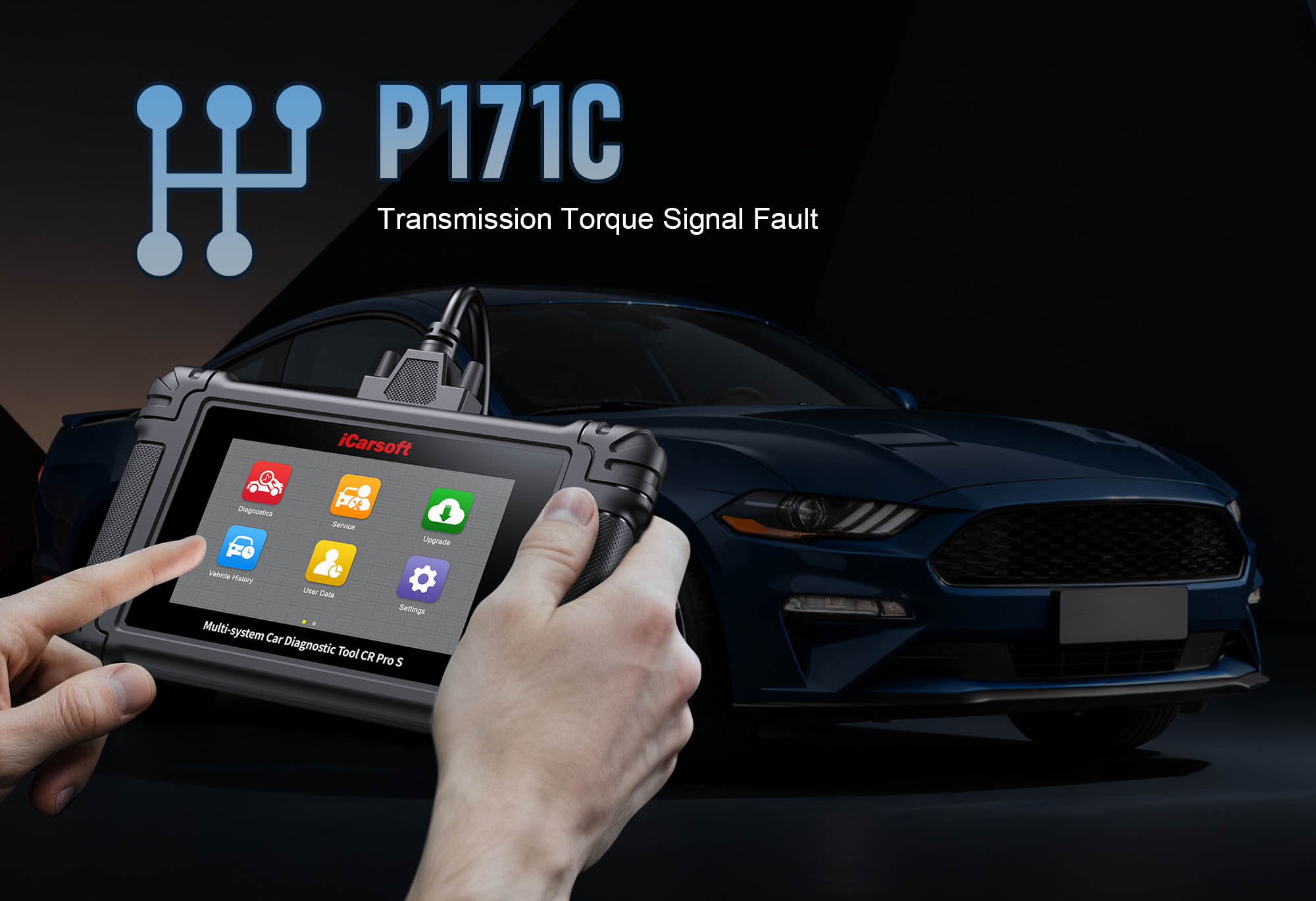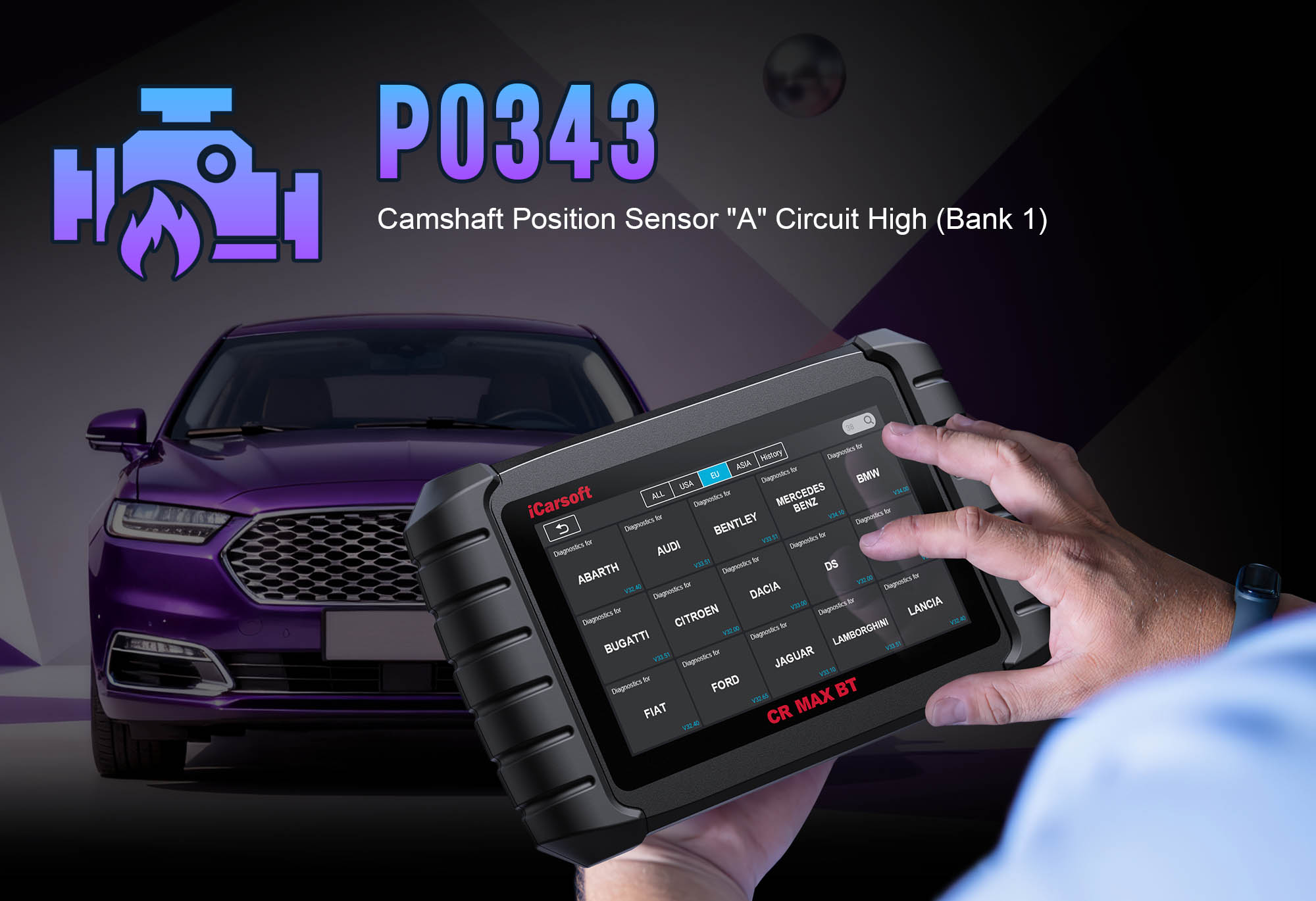Understand & Fix P171C: Transmission Torque Converter Clutch Circuit Performance with iCarsoft CR Pro S
If your vehicle experiences slipping during acceleration, delayed gear engagement, or reduced fuel efficiency, a diagnostic scan will likely return P171C. This manufacturer-specific OBD-II code (common in Ford, GM, and Chrysler vehicles) stands for "Transmission Torque Converter Clutch (TCC) Circuit Performance." The torque converter clutch is critical for linking the engine to the transmission—when engaged, it eliminates slippage at cruising speeds, boosting efficiency. A "circuit performance" error means the Transmission Control Module (TCM) detects irregular signals in the TCC circuit, preventing proper clutch engagement/disengagement.
Basic scanners might only flag a "generic transmission error" but can’t test TCC solenoid responsiveness, monitor clutch pressure, or validate circuit integrity—leaving you guessing between a faulty solenoid, wiring issues, or a failing torque converter. The iCarsoft CR Pro S, with its OE-level transmission diagnostics, bi-directional control, and brand-specific code support, solves this. Below, we break down P171C, its causes, symptoms, step-by-step resolution, and 8 FAQs to answer common troubleshooting questions.
What Is P171C?
P171C focuses on the torque converter clutch circuit—a system that includes the TCC solenoid, wiring harness, connectors, and the TCM. The TCC solenoid regulates hydraulic pressure to engage the clutch (locking the torque converter to the transmission input shaft) at cruising speeds. The TCM sends voltage signals to activate the solenoid; a "performance" error indicates the TCM receives erratic, weak, or no feedback from the circuit, signaling a malfunction in the solenoid, wiring, or related components.
Note: P171C is brand-specific—for example, Ford links it to TCC circuit voltage irregularities, while GM associates it with clutch slip detection. The iCarsoft CR Pro S’s brand-specific database clarifies the exact issue for your vehicle.
Key Symptoms of P171C
-
Illuminated Check Engine/Transmission Warning Light: The primary warning sign, often paired with codes like P0740 (TCC circuit malfunction) or P1740 (TCC pressure control fault).
-
Torque Converter Clutch Slippage: RPMs spike without a corresponding increase in vehicle speed at cruising speeds (50+ mph).
-
Delayed or Harsh Gear Shifts: The TCM adjusts shift timing to compensate for TCC issues, leading to rough engagement.
-
Poor Fuel Economy: Unlocked torque converter increases fuel consumption by 10–15% (no slip-free power transfer).
-
Transmission Overheating: Slippage generates excess heat, triggering the transmission temperature warning light (if equipped).
-
Limp Mode: The TCM may restrict the transmission to a lower gear to prevent damage, limiting speed to 30–40 mph.
Common Causes of P171C
|
Cause
|
Description
|
|
Faulty TCC Solenoid
|
Worn internal components (e.g., stuck valve, electrical failure) prevent proper pressure regulation.
|
|
Wiring/Circuit Issues
|
Frayed wires, corroded connectors, or loose terminals disrupting signal/voltage to the solenoid.
|
|
Low/Contaminated Transmission Fluid
|
Insufficient fluid reduces hydraulic pressure, while debris clogs the solenoid or valve body.
|
|
Faulty Torque Converter
|
Worn clutch plates or internal leaks prevent the TCC from engaging fully.
|
|
TCM Malfunction
|
Rarely, the TCM’s internal driver for the TCC circuit fails to send proper commands.
|
|
Valve Body Issues
|
Stuck or leaking valves in the valve body disrupt hydraulic pressure to the TCC.
|
Why iCarsoft CR Pro S Excels at Diagnosing P171C
The CR Pro S outperforms basic tools with features tailored to transmission and TCC circuit diagnostics:
Brand-Specific Code Decoding
Breaks down P171C by manufacturer (Ford: voltage performance; GM: slip detection) for precise targeting.
Bi-Directional Solenoid Testing
Sends activation commands to TCC solenoid to verify responsiveness—distinguishes solenoid from wiring faults.
Live TCC Circuit Monitoring
Tracks solenoid voltage, hydraulic pressure, and clutch engagement status in real time.
Global Vehicle Coverage
Supports 50+ major brands with TCC-equipped transmissions, including trucks and SUVs.
40+ Hot Service Functions
Includes transmission fluid reset, TCC calibration, and valve body adaptation—critical for post-repair validation.
Component Location Tool
Pinpoints TCC solenoid and related wiring (on transmission valve body) for quick access.
Step-by-Step: Diagnose P171C with iCarsoft CR Pro S
-
Confirm P171C & Gather Brand-Specific Data
Plug the CR Pro S into your vehicle’s OBD-II port, power on the tool, and select AutoVIN Identify to auto-detect make, model, and transmission type.
Navigate to Transmission > Fault Codes > Read Codes to confirm P171C. Tap Code Details for brand-specific insights (e.g., "Ford Focus: TCC Circuit Performance; Solenoid Voltage: 0.2V, Expected: 1.0–4.0V; Check Solenoid or Wiring").
-
Analyze Live Transmission Data
Go to Transmission > Live Data > Torque Converter and monitor three key metrics:
1. TCC Solenoid Voltage: Fluctuates 0V (disengaged)–12V (engaged) per TCM commands. Fixed/out-of-range values confirm P171C.
2. Transmission Fluid Temperature: Optimal 175–225°F (79–107°C)—overheating = TCC slip.
3. TCC Engagement Status: Should show "Locked" at 50+ mph—"Unlocked"/"Slip Detected" = issues.
-
Test the TCC Solenoid & Circuit
1. Use Bi-Directional Control > Transmission > TCC Solenoid Test: Send activation commands. Listen for clicking and check voltage adjustment. No response = faulty solenoid.
2. Locate the solenoid: Use the CR Pro S’s Component Location tool (on transmission valve body, accessible via pan/side cover).
3. Inspect & Test: Check for damage, debris, or oil leaks. Use Resistance Test (match OEM specs, e.g., 10–30 ohms—open/infinite = faulty solenoid).
-
Inspect Wiring, Fluid, & Valve Body
1. Wiring Check: Use Continuity Test on TCC circuit wiring for breaks/shorts. Look for damage near heat sources or moving parts.
2. Fluid Check: Verify level (engine running, transmission in park) and condition (clear red/pink = good; brown/black = contaminated). Perform fluid change via Transmission Fluid Service if needed.
3. Valve Body Inspection: Remove (if accessible) to check for clogged passages or stuck valves. Clean or replace if damaged.
-
Repair & Clear the Code
- Replace TCC solenoid if faulty. Repair wiring, clean valve body, or fix fluid issues. Professional torque converter replacement may be needed for worn units.
- Use the CR Pro S to Clear Codes and run TCC Calibration (under Special Functions) to sync with TCM.
- Test drive at varying speeds, focusing on TCC engagement at cruising speeds. Monitor live data to confirm proper locking.
FAQs: P171C Troubleshooting
Can I drive with P171C?
Short trips are possible, but prolonged driving worsens TCC slip, overheats the transmission, and risks costly damage. Diagnose with the CR Pro S immediately.
How much does it cost to fix P171C?
A new TCC solenoid costs $50–$200, plus $150–$300 for labor. Fluid service adds $150–$300. Torque converter replacement costs $800–$2,000. The CR Pro S saves on diagnostic fees ($100–$250).
Why does P171C keep returning after clearing it?
The root cause wasn’t fixed. Common culprits: unaddressed fluid contamination, hidden wiring damage, or a worn torque converter. Use the CR Pro S’s History Log to track recurrence.
Is P171C the same across all vehicle brands?
No—P171C is brand-specific (Ford = voltage performance; GM = slip detection). The CR Pro S’s brand-specific database clarifies the exact issue.
How do I distinguish between a faulty solenoid and low fluid?
Compare live data: Solenoid doesn’t respond + normal fluid level = faulty solenoid; Solenoid responds + low fluid level = fluid-related pressure issue.
Do I need to reset the TCM after replacing the TCC solenoid?
Yes—use the CR Pro S’s TCM Reset function to clear old adaptive data and ensure proper TCC engagement.
Can dirty transmission fluid cause P171C?
Yes—debris clogs the TCC solenoid or valve body, disrupting pressure. Use the CR Pro S’s Fluid Condition Monitor (where supported) to check quality.
Will P171C affect my vehicle’s towing capacity?
Yes—TCC slip reduces power transfer, limiting towing capability and increasing transmission stress. Fix P171C with the CR Pro S before towing.
Conclusion
P171C’s TCC circuit performance fault threatens transmission longevity and fuel efficiency, but the iCarsoft CR Pro S simplifies diagnosis with brand-specific decoding, bi-directional testing, and calibration tools. It ensures you fix the root cause—whether it’s a faulty solenoid, low fluid, or wiring issues—instead of just clearing the code.
With a 5-inch touchscreen, lifetime free updates, and coverage for 50+ brands, the CR Pro S is a must-have for DIYers and mechanics. Resolve P171C, restore smooth torque converter operation, and avoid costly transmission rebuilds—all with one professional-grade diagnostic scanner.





